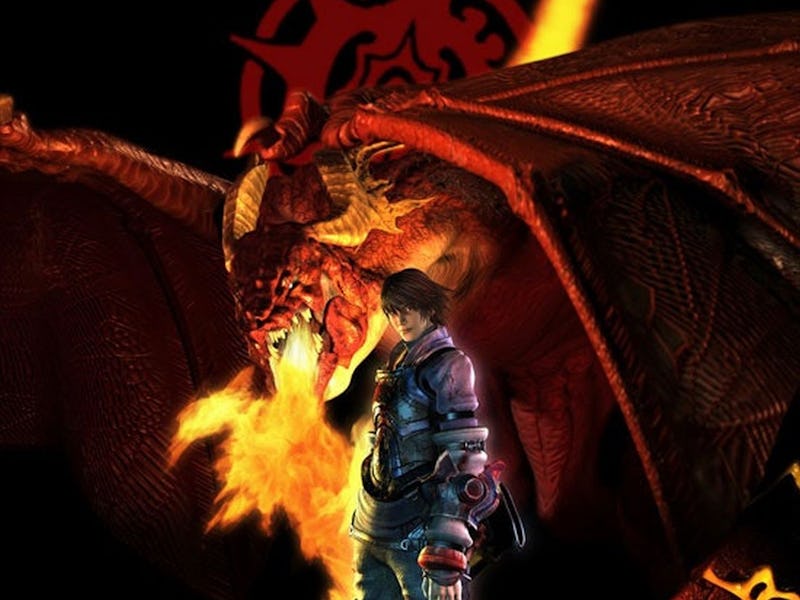19 years ago, the best bad video game ever transformed the medium
Good to be bad.

Drakengard is one of the worst games I have ever played. Drakengard is one of the best gaming experiences I have ever had. Both statements are true.
Drakengard is a game of contradictions. Born out of its director’s frustration at the limits of the medium, Drakengard condemns traditional game design mentality to challenge players to ask why games are the way they are, and if they can be something more. 19 years after its initial release, the gaming industry could still learn from it.
Drakengard doesn’t want you to have fun. But nobody ever said video games had to be fun.
Point break
Drakengard’s cast is full of detestable people living in a detestable world.
A cannibal with a taste for children, a pedophile, and a kid stuck in perpetual youth walk into a bar. Sounds like a bad joke. All three characters exist in Drakengard, and they are your closest allies. Overall, they are detestable, miserable people. Worse than these three is Caim, the protagonist, a killing machine convinced of his own righteousness and driven by an incestuous lust for his sister.
Released in 2003, Drakengard was directed by Yoko Taro, known today for his work on the Nier franchise. In the two decades since its initial release games have pushed the boundaries of dark narratives but Drakengard still stands as one of the most aggressively disturbing and miserable plots the medium has to offer. It makes The Last of Us Part II feel like a ray of sunshine.
Abrasive gameplay makes the player suffer alongside the characters.
Mechanically it is a combination of Dynasty Warriors and Ace Combat. Gameplay switches between large battle stages and air combat where Caim rides a dragon. To say the combat is messy is an understatement, it is abrasive. The PlayStation 2 era of games was never the smoothest, but Drakengard stands out amongst the rest as a game that feels like it is fighting back against the player, daring them to give up. As an RPG, Caim can level up and gather a multitude of weapons if you are willing to grind hard enough.
Caim and his companions are all immensely flawed individuals who are pushed to the breaking point in their attempt to keep the world from ending. The mental toll it takes on all of them is irreparable. Drakengard’s gameplay forces the player to suffer the same way Caim does, it hates the player and wants to break them.
Sound and fury
Drakengard seeks to break from the need to gratify the player.
Video games haven’t changed much in the two decades since Drakengard. Better hardware, prettier graphics, and more immersive gameplay; none of these things change the core of what the medium is. At their heart games are about player gratification. Rewarding new gear, offering collectibles, making a number go up when you kill an enemy. All of these things keep the player entertained.
Games remain trapped by this need to give the player exactly what they want. Drakengard is a massive middle finger to this idea. There is no part of Drakengard that attempts to be welcoming to a player, instead actively trying to make them quit the game. Drakengard, like the Nier franchise, contains multiple endings. To reach the elusive Ending E, the player must collect all 65 weapons in the game. What is the reward for this accomplishment? A joke.
Ending E sees Caim transported to modern-day Tokyo to defeat the final boss. It is a visual homage to The End of Evangelion inspired by the notorious joke endings of the Silent Hill franchise.
All of the work the player put in results in the game laughing at them.
Yoko Taro sees the games industry as stuck but remains hopeful about the potential of the medium.
But players didn’t know how to take a joke. This ending became an obsession as they created their own meaning instead of dealing with the possibility that their work meant nothing. Eventually, Ending E became the basis for Nier, which led to Nier Automata. Nier Automata’s massive success has earned Yoko Taro a reputation as one of gaming’s best creators.
The misery of Drakengard is rooted in violence. The misery of the characters as well as the player stem from the need to kill and continue cycles of violence. It begs the player to stop, making the act of killing feel miserable. Taro despises this need for violence in games, specifically those created by AAA publishers. Drakengard is an attempt to confront this by taking it to its furthest extreme and seeing what the industry will do. But the only criticism of the gameplay was that the act of killing should have been smoother.
“I think that these types of killing games will continue to permeate the industry,” Taro said in 2014, “there has been no revolution or great change. I perceive that as a failure. At least for me, it’s a personal failure.”
In the 19 years since its release, Drakengard still stands as a challenge to the industry and to players. It stands as a challenge to Taro himself. However he keeps creating games, in hopes that someday things will change, “I remain convinced of the tremendous potential in games.”
This article was originally published on